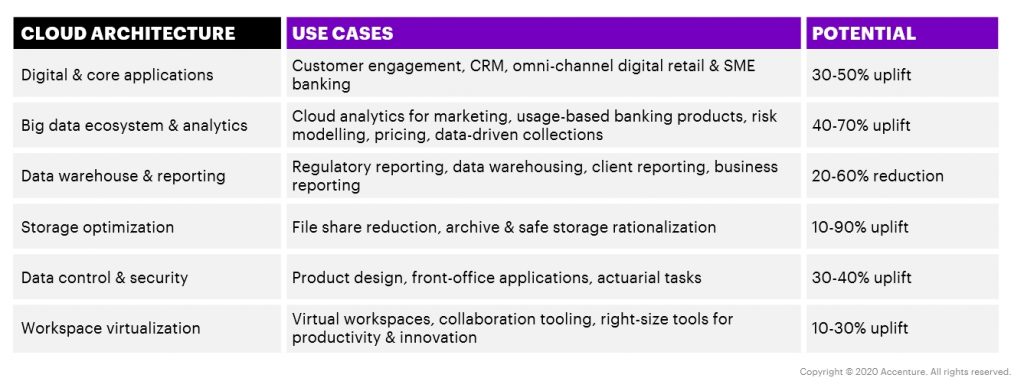Other parts of this series:
- Digitally Mature Banks: Why the Future’s in Their Hands
- COVID-19 Resilience, Digital Maturity and Outperformance
- Digital Maturity + COVID-19 Resilience = Strategy
- Digitise for Efficiency and Agility
- A future-ready approach: Building “Living Systems” for banks
- Restructure to Survive: How to turn around the weakest banks
- A future-ready approach: Journey to the cloud
- Banking’s cloud imperative: Succeeding in an altered landscape
This series of blogs looks at the future of banking in Growth Markets in a post-COVID-19 world.
Banks need a clear approach to eliminate their legacy technology debt and attain future-ready systems. That means taking the journey to the cloud – a typically incremental process by which banks shift their core-systems architecture to a flexible, cloud-native one.
Cloud-based, modular and scalable systems eradicate legacy technology constraints. They also let banks take advantage of hyper-scaling capabilities. Indeed, becoming a future-ready bank requires a cloud-based approach.
Beyond legacy tech
It’s worth outlining some of the key operational constraints that legacy technology imposes. For a start, such systems mean banks can’t innovate at speed and have limited capacity to scale to the volumes needed for digital banking. They are also costly to maintain and increasingly difficult to upgrade and secure.
Cloud-based solutions overcome these challenges, which goes some way to explaining why they’ve become popular with clients in recent years. Research by our cloud experts panel shows banking is among the leading industries in cloud adoption (see chart).

The state of cloud adoption across selected industries (Source: Accenture)
It’s not hard to build a value case for a cloud-based approach. First, such solutions help banks to run an agile business, the importance of which the COVID-19 pandemic has highlighted. Second, they ensure banks can be innovative, which is crucial in an age of digital business. Third, they allow banks to transform the cost curve, with evidence that cloud solutions cost less – particularly for products and transactions that require surge capacity.
The benefits don’t end there. Cloud-based solutions can incorporate the data-streaming and data-sharing requirements of Open Banking more easily than legacy systems can, and they bring the ability to access API-driven ecosystems. They also confer improved data management and analytics.
Finally, cloud service providers (CSPs) know that security and dynamic risk management are crucial, and they have invested heavily in those areas as a result. (That said, banks should know that they remain responsible for their use of the cloud, and they should audit and assess the risks associated with their CSPs.)

Banking Cloud Altimeter | Volume 6: Banks need a flight plan to navigate the cloud.
LEARN MOREUltimately, the benefits include greater efficiency, improved customer engagement and better targeting of products and services. They can be directly financial too. One US multinational investment bank, for instance, built a private cloud to centralise many of its functions. In building a cost-effective, efficient, scalable and secure IT platform, it cut IT spend by more than US$500m and saw workloads run 40 percent more efficiently.
Taking the first step: public, private or hybrid?
Banks that are beginning the journey face many possible paths. They can deploy cloud architecture in a range of areas, including core applications, big-data ecosystems, analytics and data warehousing, and improving performance across their operations (see table).

The state of cloud adoption across selected industries (Source: Accenture)
Whichever direction they head in, banks can’t tarry too long. COVID-19’s impact on customer behaviour and the workplace underscores the need for fundamental technological transformation, which cloud-based architecture can bring. The mismatch between needs and capabilities, especially during the early stages of the pandemic, also emphasised the imperative of finding new ways to work, using more agile, responsive and scalable technology.
In this way, COVID-19 has taken the existing cloud trend and forced banks (and others) to re-evaluate the speed at which their journey to the cloud needs to happen.
Many, however, have yet to take the necessary steps. They can start by considering the various cloud options:
- A public cloud, like those run by AWS, Microsoft Azure and Google Cloud, offers lower and more variable costs, near-unlimited scalability and high reliability.
- A private cloud, which gives full control to the bank, allows a higher level of control and performance. It also brings regulatory simplicity and flexibility, as the organisation can customise its cloud environment to meet its needs.
- A hybrid cloud, which provides a mix of the two, offers improved control as the organisation can maintain a private infrastructure for its sensitive assets, yet benefit from the flexibility that the additional resources of a public cloud bring. Additionally, this approach is simpler in that it allows for a gradual transition to the cloud, phasing in workloads over time.
In our experience, most banks will benefit from a multi-cloud strategy, which means using more than one public CSP or a mix of private and public clouds. That’s a path that many have followed, and that’s because each major CSP has discernible strengths and weaknesses – a subject that lies outside the scope of this blog.
My next blogs describe migration to the cloud in greater detail, with the first examining seven core advantages that the cloud brings for banks in growth markets.
If you’d like to learn more about how to make your bank’s journey to the cloud a success, please contact Fergus Gordon here.











